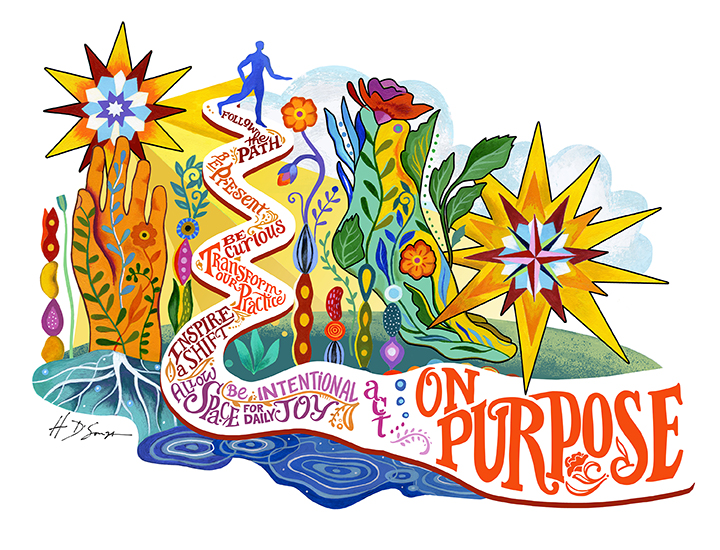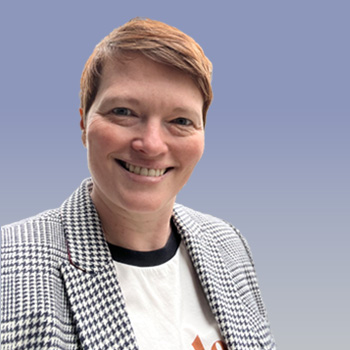

We all have a unique origin story. Here’s mine …
Our family farm was down a long, gravel road. I walked barefoot everywhere, climbed trees, swam in creeks and danced in the summer rain.
I went to a small school in a small town, with one yellow flashing traffic light and no gas station — a pass-through place where time stood still. I learned to be shy about sharing myself. I was different, sensitive, socially awkward. My sense of place, of being rooted to the earth, valuing my environment, craving community (despite being a legit introvert) and my earnest search for purpose began here.
In second grade, I wrote a letter to my future self.

It was a time capsule message and, yes, when I opened it as an adult, I was a nurse! Today, I work in a hospital. I am an artist. To teach is to learn, and I am a student of life. I live in the city but find hours of solace in my container garden. I want to be the Easter Bunny (I admit, this still sounds fun).
I didn’t always know that I was meant to be a nurse.
My path has followed the contours of living, and the years I spent finding my way to nursing were not a detour. I am a second-career nurse, and after studying art, I came to nursing because I was searching for a way to both make a difference and find personal stability. I was seeking purpose and practicality.
Things change. People change. Let there be room for change and wonder. That spirit of inquiry is the foundation of empathy for others, and an opening for art, beauty and purpose in our work.
On my first day as a nurse, I was told, “New grads don’t belong in this clinical space.”
When I asked a question, they replied, “You don’t know that already?”
When I cried on a shift, I was asked, “Is this the path for you?”
I almost walked away from nursing. Maybe my second-grade self was right: This hospital world was not for me. But I stuck it out.
To survive, I put on the mask of an ICU nurse. It’s a mask of false courage, a construct to put others at ease and to keep my tender heart safe. To guard against the very burnout the mask came to represent. This is one way we acquire unhealthy coping behaviors. And then we teach these behaviors to others. It’s time to break that cycle.
Burnout. Mindfulness. Resilience. These are the conversations we don’t know how to begin. Sometimes it's just easier not to talk about it. The way these words may have been misused in the past only increases our apprehension. I say nurses need evidence and skills that better prepare them for the clinical world. I didn’t have these skills when I was a new nurse. I learned by trial and error. Now, I’m a nurse educator and honestly still a student, motivated to speak plainly about the issues and not get lost in the words, so that we can learn together.
With human lives in the balance, moral distress is a terrible but expected professional risk, even within an ethical and well-resourced practice. All the more reason for us to normalize our profession’s need for advanced clinical, professional and personal skills.
Moral distress is not human frailty; it’s not personal failure. It is a sign of caring. And when we or our colleagues need support, we can talk openly and factually about burnout, mindfulness and personal resilience strategies.
It isn’t about having a superpower or being born to be a nurse. Artists are not necessarily gifted with innate talents but undertake a practice that is meant to last a lifetime. It isn’t about faking it until you make it; practice it until you become it.
We all came here today by a different path, bringing our unique experiences and our humanity to the profession. We can simultaneously elevate nursing care through evidence-based standards and bring it to life through the art of individualized caring practice.
I am proud to be the first AACN president to be a Clinical Scene Investigator (CSI) Academy alum! CSI Academy showed me what to do with my curiosity to help improve the delivery of care on my unit. The optimal way to drive change from the bedside is to give nurses autonomy over their practice. This just makes sense; it just makes sense. AND it improves outcomes and saves money. Practice improvement. Evidence-based practice. Nursing research. These are the foundations of nursing autonomy. How we revitalize our practice and bring joy to our work. How we shape and transform healthcare.
We learn. We grow. We get better.
We find intentional joy through the collaborative pursuit of practice improvement, because we know that celebrations are too few and far between to wait for them. Through the wisdom and examples of others, we find our best selves. Peer support is an essential balance to the daily challenges we face. In community, we can inspire a culture shift, a transformation of practice that will build the healthcare system AACN envisions, driven by the needs of patients and families where acute and critical care nurses make their optimal contribution.
We didn’t get here alone. And we cannot shape the future of nursing alone.
We are nurses. We are leaders. But we are also artists and architects and gardeners.
We are building the future. Together.
Together, we grow it … On Purpose.
Join me in a year of intentional practice. On Purpose, how will you cultivate joy and spread it to colleagues, patients and families? Email me at onpurpose@aacn.org.